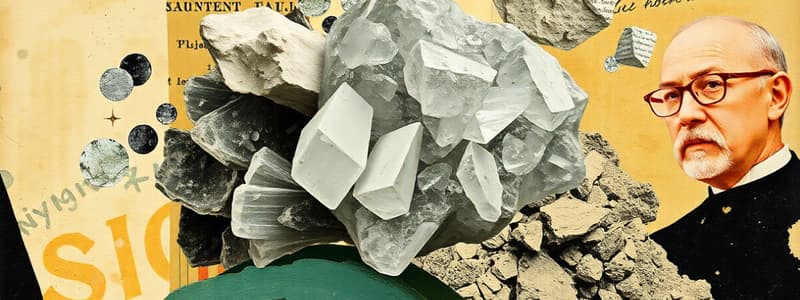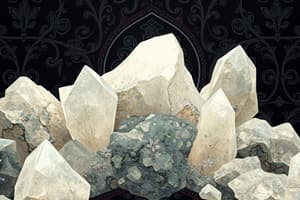Podcast
Questions and Answers
Which of the following is a fundamental characteristic of a mineral?
Which of the following is a fundamental characteristic of a mineral?
- Organic composition derived from living organisms
- Naturally occurring and inorganic (correct)
- Amorphous structure without a definite volume
- Liquid state at room temperature
Why is color considered a less reliable property for mineral identification?
Why is color considered a less reliable property for mineral identification?
- Trace impurities can significantly alter a mineral's color. (correct)
- Color is always consistent within a mineral species.
- Color is enhanced by weathering processes.
- All minerals exhibit a unique color spectrum allowing unambiguous identification.
What property of a mineral is assessed by observing the color of its powder when rubbed against a streak plate?
What property of a mineral is assessed by observing the color of its powder when rubbed against a streak plate?
- Streak (correct)
- Hardness
- Cleavage
- Luster
A mineral can scratch glass (hardness of 5.5) but is scratched by corundum (hardness of 9). Which of the options below could be the Mohs hardness of the mineral?
A mineral can scratch glass (hardness of 5.5) but is scratched by corundum (hardness of 9). Which of the options below could be the Mohs hardness of the mineral?
Which characteristic describes the breakage of a mineral along smooth, flat surfaces?
Which characteristic describes the breakage of a mineral along smooth, flat surfaces?
A mineral that allows light to pass through it, so objects are clearly visible through it is described as:
A mineral that allows light to pass through it, so objects are clearly visible through it is described as:
What is described as the appearance of a mineral surface in reflected light, and is broadly categorized as either metallic or nonmetallic?
What is described as the appearance of a mineral surface in reflected light, and is broadly categorized as either metallic or nonmetallic?
Which property describes a mineral's resistance to breaking, bending, or tearing, often categorized as brittle, malleable, or ductile?
Which property describes a mineral's resistance to breaking, bending, or tearing, often categorized as brittle, malleable, or ductile?
Which of the following is a property of a mineral that describes its ability to be sliced with a knife?
Which of the following is a property of a mineral that describes its ability to be sliced with a knife?
Quartz is composed of which two chemical elements?
Quartz is composed of which two chemical elements?
How does the presence of iron impurities affect the color of quartz?
How does the presence of iron impurities affect the color of quartz?
What causes the white color observed in milk quartz?
What causes the white color observed in milk quartz?
What process leads to the smoky color in certain varieties of quartz?
What process leads to the smoky color in certain varieties of quartz?
Which element is responsible for the yellow color in citrine quartz?
Which element is responsible for the yellow color in citrine quartz?
What causes the pale pink to rose-red hue in rose quartz?
What causes the pale pink to rose-red hue in rose quartz?
Which of the following minerals is most likely to display a metallic luster?
Which of the following minerals is most likely to display a metallic luster?
Which of the following minerals is most likely to display a dull or earthy luster?
Which of the following minerals is most likely to display a dull or earthy luster?
Which mineral is known for a 'waxy' luster?
Which mineral is known for a 'waxy' luster?
What type of luster is exhibited by quartz?
What type of luster is exhibited by quartz?
A mineral that can be hammered into thin sheets demonstrates what type of tenacity?
A mineral that can be hammered into thin sheets demonstrates what type of tenacity?
What term describes the tenacity of a mineral that turns into powder when hammered?
What term describes the tenacity of a mineral that turns into powder when hammered?
What term describes the tenacity of a mineral that can be stretched into wire?
What term describes the tenacity of a mineral that can be stretched into wire?
Which of these types of tenacity describes minerals that can be bent but do not return to their original shape?
Which of these types of tenacity describes minerals that can be bent but do not return to their original shape?
Which of these types of tenacity describes minerals that return to its original position after stress is released?
Which of these types of tenacity describes minerals that return to its original position after stress is released?
Which mineral is known to be both elastic and heat-resistant?
Which mineral is known to be both elastic and heat-resistant?
If a mineral looks black but produces a red-brown streak, what is the mineral?
If a mineral looks black but produces a red-brown streak, what is the mineral?
If a mineral looks grey but produces a light-brown streak, what is the mineral?
If a mineral looks grey but produces a light-brown streak, what is the mineral?
Gold will leave what color of streak?
Gold will leave what color of streak?
Pyrite will leave what color of streak?
Pyrite will leave what color of streak?
Which of the following minerals displays cleavage in one direction because of weak bonding?
Which of the following minerals displays cleavage in one direction because of weak bonding?
Which of the following minerals displays cleavage in two directions?
Which of the following minerals displays cleavage in two directions?
Which of the following is an example of a naturally occurring mineral?
Which of the following is an example of a naturally occurring mineral?
A mineral found in nature is analyzed and discovered to have a unique, repeating arrangement of atoms. Which characteristic does this describe?
A mineral found in nature is analyzed and discovered to have a unique, repeating arrangement of atoms. Which characteristic does this describe?
Which process refers to the breakage of a mineral along irregular surfaces?
Which process refers to the breakage of a mineral along irregular surfaces?
Flashcards
What are minerals?
What are minerals?
Minerals are the building blocks of rocks, present in soil and water, absorbed by plants, or consumed by animals.
Naturally Occurring & Inorganic
Naturally Occurring & Inorganic
Minerals are formed through earth's natural processes without organic matter.
Definite Volume and Rigid Shape
Definite Volume and Rigid Shape
Minerals have a consistent volume and maintain a rigid shape.
Orderly Crystalline Structure
Orderly Crystalline Structure
Signup and view all the flashcards
Color of minerals
Color of minerals
Signup and view all the flashcards
Quartz Composition and Color
Quartz Composition and Color
Signup and view all the flashcards
Streak of a mineral
Streak of a mineral
Signup and view all the flashcards
Hardness of a mineral
Hardness of a mineral
Signup and view all the flashcards
Cleavage vs. Fracture
Cleavage vs. Fracture
Signup and view all the flashcards
Diaphaneity/Transparency
Diaphaneity/Transparency
Signup and view all the flashcards
Luster of a mineral
Luster of a mineral
Signup and view all the flashcards
Tenacity of a mineral
Tenacity of a mineral
Signup and view all the flashcards
Brittleness
Brittleness
Signup and view all the flashcards
Malleability
Malleability
Signup and view all the flashcards
Ductility
Ductility
Signup and view all the flashcards
Flexible but Inelastic
Flexible but Inelastic
Signup and view all the flashcards
Flexible and Elastic
Flexible and Elastic
Signup and view all the flashcards
Sectility
Sectility
Signup and view all the flashcards
Study Notes
- Minerals are the building blocks of rocks.
- Minerals are inorganic elements present in soil and water, which are absorbed by plants or consumed by animals.
Characteristics of Minerals
- They occur naturally as part of earth's natural processes.
- They are inorganic, meaning they are not a product of an organism or come from living matter.
- Minerals have a definite volume and rigid shape.
- They have an orderly crystalline structure where atoms are arranged in an orderly and repeating pattern.
Physical Properties of Minerals
- Color is the most obvious but often misleading way to identify a mineral and is the least useful because many minerals have similar colors.
- Different colors may result from impurities, or they can change colors due to different circumstances.
- Color is the first thing someone notices when they view a mineral.
- Color is one of the big reasons that attract people to minerals.
Example Quartz
- Quartz is the most common mineral.
- Quartz is made of the two most abundant chemical elements on Earth: oxygen and silicon.
- Quartz becomes colored with the presence of other minerals or growth imperfections.
- Milk quartz is the most common variety of crystalline quartz, and its white color is caused by minute fluid inclusions of gas, liquid, or both, trapped during crystal formation.
- The smoky color results from free silicon formed from the silicon dioxide by natural irradiation.
- The quartz variation amethyst has iron impurities.
- The quartz variation citrine gets its yellow color from aluminum.
- Rose quartz is a type of quartz that exhibits a pale pink to rose-red hue, and the color is usually considered due to trace amounts of titanium, iron, or manganese in the material.
Streak
- Streak is the color of a mineral in powdered form.
- Cinnabar looks grey, but always produces a light-brown streak.
- Hematite looks black, but always produces a red-brown streak.
- Gold leaves a yellow streak, and pyrite will leave a greenish-black streak, which can be used as a test to see if you have pure gold or pyrite.
Hardness
- Hardness is a measure of a minerals relative resistance to scratching.
- Mohs scale of mineral hardness is a scale to measure relative resistance to scratching.
Cleavage and Fracture
- Cleavage is the tendency of a mineral to break along smooth planes parallel to zones of weak bonding.
- Fracture is the tendency of a mineral to break along curved surfaces without a definite shape.
- Minerals that fracture do not have planes of weakness and break irregularly.
- Cleavage planes are smooth, flat, parallel planes within the crystal.
- Cleavage planes may show as reflective surfaces on the crystal, as parallel cracks that penetrate into the crystal, or show on the edge or side of the crystal as a series of steps like rice terraces.
- Fracture is different than cleavage in that the broken surface will not be flat or even.
- The breakage does not occur along a distinct plane within the crystal in fracture.
Diaphaneity/Transparency
- Diaphaneity/transparency is the ability to allow light to pass through.
- Describes how well light passes through a mineral.
- There are 3 degrees of transparency: transparent, translucent, and opaque.
- Transparent allows light to pass through.
- Translucent depends on thickness and the light may or may not pass through or be absorbed.
- Opaque doesn’t allow light to pass through.
Luster
- Luster is how light is reflected off a surface.
- It is the appearance of a mineral surface in terms of its light-reflective qualities.
- Luster depends upon a mineral's degree of transparency.
- There are two types: metallic and nonmetallic.
- Metallic luster looks like shiny metal such as chrome, steel, silver, or gold.
- Metallic minerals are always opaque.
- Non-metallic minerals may be shiny and reflect light, however, they do not look like a metal.
Metallic Luster Examples
- Just like metals they reflect light
Non-Metallic Luster Types & Examples
- Dull or Earthy minerals shine minimally to none.
- Waxy minerals shine like wax.
- Vitreous or Glassy minerals shine like broken glass.
- Silky minerals shine like silk.
- Pearly minerals shine iridescently, like a pearl.
Tenacity
- Tenacity describes the reaction of a mineral to stress such as crushing, bending, breaking, or tearing.
- Minerals react differently to each type of stress and it is is possible for a mineral to have more than one type of tenacity.
Tenacity Classification
- Brittleness is when a mineral turns into powder when hammered.
- Malleability is when a mineral can be flattened by pounding with a hammer.
- Ductility is when a mineral can be stretched into wire.
- flexible but inelastic minerals are bent but they remain in the new position after they are bent.
- Flexible and elastic minerals return to their original position after stress is released.
Sectility
- Sectility is the ability of minerals to be sliced by a knife.
Studying That Suits You
Use AI to generate personalized quizzes and flashcards to suit your learning preferences.




